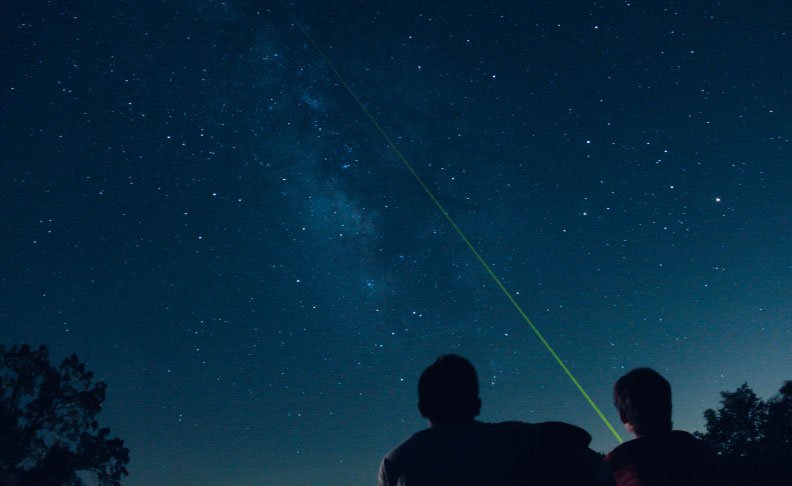
On July 28 at 9 p.m. AZ/PDT, Lowell Observatory will host a free livestream highlighting the Southern Delta Aquariid and Alpha Capricornid meteor showers. Lowell Observatory Astronomer Dr. Nick Moskovitz, Research Assistant Megan Gialluca, and special guest Mike Hankey from the American Meteor Society will host the event. The team will use the All-Sky Camera at the Lowell Discovery Telescope and Hankey’s own camera system to hunt for meteors.
Both meteor showers peak on the evening of July 28/morning of July 29. These celestial displays tend to be not as flashy as the “major” meteor showers such as August’s Perseids. Yet they are still worth watching and each tells its own story about the interaction between errant space debris and Earth.
The Southern Delta Aquariids and Alpha Capricornids in 2020
The Southern Delta Aquariid Meteor Shower is active from around July 12 to August 23. During peak time, in the early-morning hours of July 29, the shower may produce up to 20, usually fairly faint, meteors per hour. The Alpha Capricornid Meteor Show runs from around July 15 to August 10. Peaking at about the same time as the Southern Delta Aquariids this year, it tops out at only 5 meteors per hour. However, what it lacks in quantity it makes up for in quality—its meteors are much brighter, and extremely brilliant meteors called fireballs are common.
The Southern Delta Aquariids move across the sky at around 26 miles per second (41 kilometers per second)—an average rate as meteors go. The Perseids, by comparison, zoom at 37 miles per second (60 kilometers per second), while the Alpha Capricornids plod along at “only” 15 miles per second (24 kilometers per second). This difference in speed is related to the relative direction from which the meteors enter Earth’s atmosphere. This is like two cars on a road: if they are approaching each other from opposite directions, their combined speed will be higher than if they converge while moving in the same direction.
Peak time for these meteor showers falls in the predawn hours of July 2 (though for these particular showers, comparable number of meteors may be seen on several nights before and after the peak). The Moon is a day after first quarter and setting just after midnight, so its light won’t be around to wash out the meteors. As in real estate, an important factor is location, location, location. The best viewing will be away from the glow of streetlights and other illuminating interlopers. Also important is WHERE to look—both meteor showers will be radiating from a point low on the southern horizon (as seen from mid-northern latitudes such as Flagstaff). While meteors may be seen in any part of the sky, this southerly direction should reveal the most. An added bonus while searching for these meteors: the planets Jupiter, Saturn, and Mars will also visible in the sky, plus the Perseid Meteor Shower, while not peaking until August 11/12, is now active.
More About Meteor Showers
Meteors are small—usually sand-sized—particles of space debris that sail into Earth’s atmosphere and burn up. They may be seen on any given night. Then there are meteor showers, concentrations of meteors that usually result from a comet traveling to the inner parts of the solar system as it orbits the Sun. Each time the comet visits, it warms up and discharges some of its gases and dust. Over time, these sand-sized grains of debris spread somewhat uniformly throughout the comet’s orbit. If this orbit of debris happens to intersect with the orbit of Earth, then numerous pieces come in contact with Earth’s atmosphere and burn up, creating a shower of meteors.
Meteor showers are named for the constellation from which they appear to radiate: The Perseids are based on Perseus, the Leonids on Leo, and so on. In some cases, a single constellation may contain the so-called radiant point of more than one meteor shower so the shower name also indicates a particular star within the constellation. The Alpha Capricornid Meteor Shower is named after the star Alpha Capricornus. Taking this one step further, some meteor showers exhibit similar but separate branches. The Delta Aquariid Meteor Shower is named after the Delta Aquarius, and scientists have identified two versions, the “Southern” and “Northern”.
Astronomers hypothesize that Comet 96P/Machholz is the parent comet of the Southern Delta Aquariids. American amateur astronomer Donald Machholz discovered this “dirty snowball” in 1986. Its nucleus measures four miles (six kilometers) in diameter and it orbits the Sun every 5.3 years. Lowell Observatory astronomer and comet expert Dave Schleicher studied Comet 96P/Machholz in 2007 and found that its chemical composition is much different than most others studied. The reason is unclear, but one idea suggests the comet may have originated from outside of our solar system, where the chemical makeup is different.
In 2010, astronomers Peter Jenniskens and Jeremie Vaubaillon identified Comet 169P/NEAT as the parent comet of the Alpha Capricornids. Discovered in 2002 by the asteroid hunting program nicknamed NEAT (for Near-Earth Asteroid Tracking), Comet 169P/NEAT is smaller than Comet 96P/Machholz and circles the Sun every 4.2 years.
According to Jenniskens and Vaubaillon, the Alpha Capricornids were created about 3,500 to 5,000 years ago, when much of Comet 169P/NEAT broke apart, leaving a dust trail that just recently began passing through Earth’s orbit. Jenniskens and Vaubaillon suggest that the majority of the debris will not enter Earth’s orbital path for several hundred years but when it does, the Alpha Capricornids will become a major meteor shower, more active than any modern-day shower.
To participate in this livestream, click below!